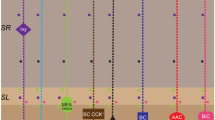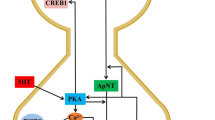Abstract
Electrophysiological recordings were used to explore the role of group II and III metabotropic glutamate receptors (mGluRs) in oscillatory patterns generated by the neonatal rat spinal cord in vitro. Neither the group II agonist DCG-IV (and the selective antagonist EGLU), nor the group III agonist l-AP4 (and its selective antagonist CPPG) had any effect on lumbar motoneuron membrane potential or input resistance. This observation suggests that motoneurons expressed no functional group II and III mGluRs and received no network-based, tonic influence mediated by them. DCG-IV or l-AP4 strongly depressed synaptic responses evoked by single dorsal root (DR) stimuli, an effect counteracted by their respective antagonist. EGLU or CPPG per se had no effect on synaptic responses, indicating no mGluR autoreceptor-dependent control of transmitter release. l-AP4 largely depressed cumulative depolarization, windup and associated oscillations, whereas synaptic depression induced by DCG-IV waned with repeated stimuli. l-AP4 slowed down fictive locomotor patterns and arrested disinhibited bursting, which could, however, be promptly restored by DR electrical stimulation. DCG-IV had no significant effect on fictive locomotion, but it blocked disinhibited bursting. EGLU facilitated bursting, suggesting that burst termination was partly controlled by group II mGluRs. All these effects were reversible on washout. It is concluded that activation of group II and III mGluRs differentially modulated rhythmic patterns recorded from motoneurons via network-dependent actions, which probably included decrease in the release of neurotransmitters at key circuit points.





Similar content being viewed by others
References
Aronica E, Catania MV, Geurts J, Yankaya B, Troost D (2001) Immunohistochemical localization of group I and II metabotropic glutamate receptors in control and amyotrophic lateral sclerosis human spinal cord: upregulation in reactive astrocytes. Neuroscience 105:509–520
Azkue JJ, Murga M, Fernandez-Capetillo O, Mateos JM, Elezgarai I, Benitez R, Osorio A, Diez J, Puente N, Bilbao A, Bidaurrazaga A, Kuhn R, Grandes P (2001) Immunoreactivity for the group III metabotropic glutamate receptor subtype mGluR4a in the superficial laminae of the rat spinal dorsal horn. J Comp Neurol 430:448–457
Bandrowski AE, Huguenard JR, Prince DA (2003) Baseline glutamate levels affect group I and II mGluRs in layer V pyramidal neurons of rat sensorimotor cortex. J Neurophysiol 89:1308–1316
Baranauskas G, Nistri A (1996) NMDA receptor-independent mechanisms responsible for the rate of rise of cumulative depolarization evoked by trains of dorsal root stimuli on rat spinal motoneurones. Brain Res 738:329–332
Baranauskas G, Nistri A (1998) Sensitization of pain pathways in the spinal cord: cellular mechanisms. Prog Neurobiol 54:349–365
Baranauskas G, Traversa U, Rosati AM, Nistri A (1995) An NK1 receptor-dependent component of the slow excitation recorded intracellularly from rat motoneurons following dorsal root stimulation. Eur J Neurosci 7:2409–2417
Barbieri M, Nistri A (2001) Depression of windup of spinal neurons in the neonatal rat spinal cord in vitro by an NK3 tachykinin receptor antagonist. J Neurophysiol 85:1502–1511
Beato M, Nistri A (1999) Interaction between disinhibited bursting and fictive locomotor patterns in the rat isolated spinal cord J Neurophysiol 82:2029–2038
Beato M, Bracci E, Nistri A (1997) Contribution of NMDA and non-NMDA glutamate receptors to locomotor pattern generation in the neonatal rat spinal cord. Proc R Soc Lond B Biol Sci 264:877–884
Berthele A, Boxall SJ, Urban A, Anneser JM, Zieglgansberger W, Urban L, Tolle TR (1999) Distribution and developmental changes in metabotropic glutamate receptor messenger RNA expression in the rat lumbar spinal cord. Brain Res Dev Brain Res 112:39–53
Bird GC, Asghar AU, Ackley MA, King AE (2001) Modulation of primary afferent-mediated neurotransmission and Fos expression by glutamate uptake inhibition in rat spinal neurones in vitro. Neuropharmacology 41:582–591
Bracci E, Ballerini L, Nistri A (1996a) Localization of rhythmogenic networks responsible for spontaneous bursts induced by strychnine and bicuculline in the rat isolated spinal cord. J Neurosci 16:7063–7076
Bracci E, Ballerini L, Nistri A (1996b) Spontaneous rhythmic bursts induced by pharmacological block of inhibition in lumbar motoneurons of the neonatal rat spinal cord. J Neurophysiol 75:640–647
Breakwell NA, Huang L, Rowan MJ, Anwyl R (1997) DCG-IV inhibits synaptic transmission by activation of NMDA receptors in area CA1 of rat hippocampus. Eur J Pharmacol 322:173–178
Butt SJB, Lebret JM, Kiehn O (2002) Organization of left–right coordination in the mammalian locomotor network. Brain Res Rev 40:107–117
Cao CQ, Evans RH, Headley PM, Udvarhelyi PM (1995) A comparison of the effects of selective metabotropic glutamate receptor agonists on synaptically evoked whole cell currents of rat spinal ventral horn neurones in vitro. Br J Pharmacol 115:1469–1474
Cao CQ, Tse HW, Jane DE, Evans RH, Headley PM (1997) Antagonism of mGlu receptors and potentiation of EPSCs at rat spinal motoneurones in vitro. Neuropharmacology 36:313–318
Cazalets JR, Sqalli-Houssaini Y, and Clarac F (1992) Activation of the central pattern generators for locomotion by serotonin and excitatory amino acids in neonatal rat. J Physiol 455:187–204
Chen J, Heinke B, Sandkuhler J (2000) Activation of group I metabotropic glutamate receptors induces long-term depression at sensory synapses in superficial spinal dorsal horn. Neuropharmacology 39:2231–2243
Cowley KC, Schmidt BJ (1995) Effects of inhibitory amino acid antagonists on reciprocal inhibitory interactions during rhythmic motor activity in the in vitro neonatal rat spinal cord. J Neurophysiol 74:1109–1117
Darbon P, Scicluna L, Tscherter A, Streit J (2002) Mechanisms controlling bursting activity induced by disinhibition in spinal cord networks. Eur J Neurosci 15:671–683
Dong XW, Feldman JL (1999) Distinct subtypes of metabotropic glutamate receptors mediate differential actions on excitability of spinal respiratory motoneurons. J Neurosci 19:5173–5184
El Manira A, Kettunen P, Hess D, Krieger P (2002) Metabotropic glutamate receptors provide intrinsic modulation of the lamprey locomotor network. Brain Res Rev 40:9–18
Fisher K, Coderre TJ (1996) The contribution of metabotropic glutamate receptors (mGluRs) to formalin-induced nociception. Pain 68:255–263
Fisher K, Lefebvre C, Coderre TJ (2002) Antinociceptive effects following intrathecal pretreatment with selective metabotropic glutamate receptor compounds in a rat model of neuropathic pain. Pharmacol Biochem Behav 73:411–418
Gerber G, Zhong J, Youn D, Randic M (2000) Group II and group III metabotropic glutamate receptor agonists depress synaptic transmission in the rat spinal cord dorsal horn. Neuroscience 100:393–406
Herrero JF, Laird JM, Lopez-Garcia JA (2000) Wind-up of spinal cord neurones and pain sensation: much ado about something? Prog.Neurobiol 61:169–203
Ishida M, Saitoh T, Shimamoto K, Ohfune Y, Shinozaki H (1993) A novel metabotropic glutamate receptor agonist: marked depression of monosynaptic excitation in the newborn rat isolated spinal cord. Br J Pharmacol 109:1169–1177
Kerkut GA, Bagust J (1995) The isolated mammalian spinal cord. Prog Neurobiol 46:1–48
Kiehn O, Kjaerulff O (1998) Distribution of central pattern generators for rhythmic motor outputs in the spinal cord of limbed vertebrates. Ann NY Acad Sci 860:110–129
Kremer E, Lev-Tov A (1997) Localization of the spinal network associated with generation of hindlimb locomotion in the neonatal rat and organization of its transverse coupling system. J Neurophysiol 77:1155–1170
Marchetti C, Beato M, Nistri A (2001a) Alternating rhythmic activity induced by dorsal root stimulation in the neonatal rat spinal cord in vitro. J Physiol 530:105–112
Marchetti C, Beato M, Nistri A (2001b) Evidence for increased extracellular K+ as an important mechanism for dorsal root induced alternating rhythmic activity in the neonatal rat spinal cord in vitro. Neurosci Lett 304:77–80
Marchetti C, Taccola G, Nistri A (2003) Distinct subtypes of group I metabotropic glutamate receptors on rat spinal neurons mediate complex facilitatory and inhibitory effects. Eur J Neurosci 18:1873–1883
Mills CD, Johnson KM, Hulsebosch CE (2002) Role of group II and group III metabotropic glutamate receptors in spinal cord injury. Exp Neurol 173:153–167
Nakayama K, Nishimaru H, Kudo N (2002) Basis of changes in left-right coordination of rhythmic motor activity during development in the rat spinal cord. J Neurosci 22:10388–10398
Onaka M, Minami T, Nishihara I, Ito S (1996) Involvement of glutamate receptors in strychnine- and bicuculline-induced allodynia in conscious mice. Anesthesiology 84:1215–1222
Pin JP, Duvoisin R (1995) The metabotropic glutamate receptors: structure and functions. Neuropharmacology 34:1–26
Pinco M, Lev-Tov A (1993) Synaptic excitation of α-motoneurons by dorsal root afferents in the neonatal rat spinal cord. J Neurophysiol 70:406–417
Rozzo A, Ballerini L, Abbate G, Nistri A (2002) Experimental and modeling studies of novel bursts induced by blocking Na+ pump and synaptic inhibition in the rat spinal cord. J Neurophysiol 88:676–691
Schoepp DD, Jane DE, Monn JA (1999) Pharmacological agents acting at subtypes of metabotropic glutamate receptors. Neuropharmacology 38:1431–1476
Sivilotti LG, Thompson SW, Woolf CJ (1993) Rate of rise of the cumulative depolarization evoked by repetitive stimulation of small-caliber afferents is a predictor of action potential windup in rat spinal neurons in vitro. J Neurophysiol 69:1621–1631
Taccola G, Marchetti C, Nistri A (2003) Effect of metabotropic glutamate receptor activity on rhythmic discharges of the neonatal rat spinal cord in vitro. Exp Brain Res 153:388–399
Thompson SW, King AE, Woolf CJ (1990) Activity-dependent changes in rat ventral horn neurons in vitro; summation of prolonged afferent evoked postsynaptic depolarizations produce a d-2-amino-5-phosphonovaleric acid sensitive windup. Eur J Neurosci 2:638–649
Thompson SW, Dray A, Urban L (1994) Injury-induced plasticity of spinal reflex activity: NK1 neurokinin receptor activation and enhanced A- and C-fiber mediated responses in the rat spinal cord in vitro. J Neurosci 14:3672–3687
Tscherter A, Heuschkel MO, Renaud P, Streit J (2001) Spatiotemporal characterization of rhythmic activity in rat spinal cord slice cultures. Eur J Neurosci 14:179–190
Uyama Y, Ishida M, Shinozaki H (1997) DCG-IV, a potent metabotropic glutamate receptor agonist, as an NMDA receptor agonist in the rat cortical slice. Brain Res 752:327–30
Vetter P, Garthwaite J, Batchelor AM (1999) Regulation of synaptic transmission in the mossy fibre-granule cell pathway of rat cerebellum by metabotropic glutamate receptors. Neuropharmacology 38:805–815
Whelan P, Bonnot A, O’Donovan MJ (2000) Properties of rhythmic activity generated by the isolated spinal cord of the neonatal mouse. J Neurophysiol 84:2821–2833
Acknowledgements
This work was supported by grants from Ministero dell’Istuzione dell’Università e della Ricerca (MIUR: COFIN, FIRB) and Instituto Nazionale di Fisica della Materia (INFM).
Author information
Authors and Affiliations
Corresponding author
Additional information
G. Taccola and C. Marchetti contributed equally to the work
Rights and permissions
About this article
Cite this article
Taccola, G., Marchetti, C. & Nistri, A. Role of group II and III metabotropic glutamate receptors in rhythmic patterns of the neonatal rat spinal cord in vitro. Exp Brain Res 156, 495–504 (2004). https://doi.org/10.1007/s00221-003-1798-5
Received:
Accepted:
Published:
Issue Date:
DOI: https://doi.org/10.1007/s00221-003-1798-5




